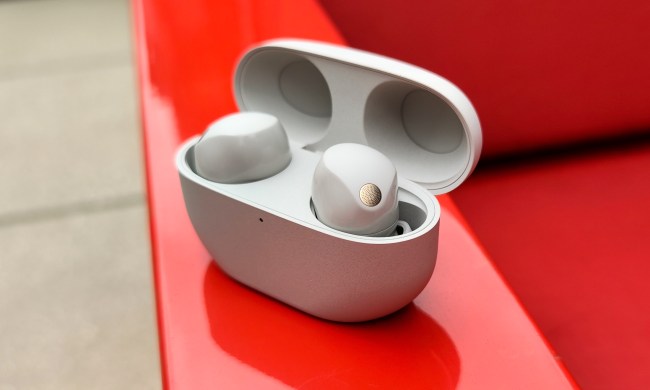- Cool looking LCD display; touch sensitive controls; excellent sound quality; nice design elements
- Slightly buggy software; requires external power; is an LCD screen really necessary?
Summary
The Logitech Z-10 suffers from one minor fault: a purpose. While the speakers look great, and sound even better, why anyone would need controls on the speakers themselves is beyond us. So, think of it as an added bonus feature that you might one day find a use for. As for the rest of the package, read on to find out if there is any more wackiness hidden from you, Joe Consumer.
Features and Design
The Logitech Z-10 2.0 speaker setup is the second peripheral that Logitech has slapped an LCD screen on. First came the G15 gaming keyboard, and we all rejoiced. But now, a 2.0 speaker setup with touch sensitive controls and an LCD screen. Why? We’ll make some suggestions at the end of the review, so stick around.
The Z-10 speakers ooze quality, and at the price you’ll be paying for two speakers ($150 at review time), they better. The first thing we noticed was that the box was as heavy as many 2.1 speaker setups, a good sign that we’ll be getting quality electronics and probably good bass. The packaging is premium quality, and the all-gloss surfaces come with a plastic peel-off protective cover so they stay smudge free. Besides the speakers themselves, you get a USB cord, male/male stereo cord, and software CD. The power cord is permanently fixed to the right speaker, which also houses the stereo port and media control buttons.
The glossy black finish is only interrupted by the speaker ports and the faded ghosts of control button images when off. Once powered on, the amber backlit buttons glow with life, and the amber LCD displays the boot sequence (the Logitech logo followed by a big “Z-10”). The media control buttons are only available if the USB connection is plugged in, otherwise only the volume up/down, and mute buttons will be accessible. The use of two connectors allows the speakers to be used for non-PC playback. Otherwise, users can control Windows Media Player, iTunes, or MusicMatch Jukebox using the controls. There are 4 shortcut keys that operate similarly to radio preset station buttons on a stereo, turning the media playing application to the internet radio station assigned.
The LCD uses the same software as the G15 keyboard, but installs its own management software. Applets can be assigned to either of the LCDs, if you should have both of the products. Otherwise, the Z-10 will install the LCD manager software, which contains the selection of applets to rotate through the display. Some, like the clock applet, have customization options, while others do not. The rate at which applets rotate through is customizable, as is the brightness and contrast.
LCD applications include a clock with date, POP3 mail checker with Outlook integration, stopwatch, performance monitor with CPU and memory usage statistics, and the media playback application.
Images Courtesy of Logitech
Testing and Use
The LCD also displays the stats for any songs playing in the supported media player – including iTunes, Windows Media Player, and MusicMatch. Track name, artist, and progress are displayed clearly. The amber touch sensitive buttons are only marked by their backlit icons. Otherwise, the surface remains unbroken and seamless. We found a couple of our buttons to be slightly off from their markings, and the volume up button would activate if we touched the side of the speaker – quite a shock when we went to nudge it from the corner of the desk!
We were disappointed to see that the Z-10s require an external power source. Even though we know there is not enough power to really give the speakers “Oomph!’ from the laptop’s audio card, we were hoping it would draw power from the USB connection. We also had one issue shortly after installing the drivers where the speakers crashed (at least that’s what we call it). Rebooting, reinstalling drivers, powering them on and off didn’t solve the problem. Out of desperation we unplugged the power and USB, waited five minutes, and plugged them in again. Problem solved. We’d like to say that this was an isolated incident, as it only happened to us once in over a month’s worth of use, but our posting on the Logitech forums with this solution was welcomed with great thanks from at least two other Z-10 owners. A minor issue? Yes. Just be aware of it.
One thing we fail to understand is what applications would have someone wanting to reach out to a speaker to adjust the song track or volume? Maybe it makes sense for those playing a full screen game, or owners of keyboards without media controls that keep many programs open at once, or quite possibly for people that play music at night and shut off their monitors to reduce the amount of ambient light. That’s about all we could come up with. Do the Z-10s look nice? You bet. But you really have to ask about the utility of adding a software controlled speaker setup. Add to that the fact that using a USB based speaker or headset will bypass your sound card, and the options collapse even further. The Z-10s are clearly designed for use with laptops or as an audio quality upgrade for PCs with onboard sound.
Image Courtesy of Logitech
Setup and Use Cont’d
So with all thee superfluous features, the price couldn’t be justified, could it? Two words: Sound quality. This is the best sounding 2.0 setup we’ve heard yet, performing as well as many 2.1 setups, without the bulky subwoofer consuming precious foot space and adding to cord clutter. The bass was ever so slightly weaker than, say, the Logitech X2300 or Z-4, but it was hardly noticeable. The Z-10s were easily able to push past the point that we would play music in the office even during non-business hours, and the quality did not suffer from distortion until the very upper limit.
You can think of the Z-10s as either an expensive 2.0 setup with extra features, or as a moderately priced 2.1 setup without the annoying subwoofer, and with extra features. Overall, if we were to compare the Z-10s to 2.1 setups, they would fall somewhere just north of $100.
We currently are using the Z-10s as our laptop speakers for the office. They remain plugged into a docking station, and are ready to serve as they are needed. This is the niche we find them best fit for: office use with a docking station. We know this is a very small market, but these speakers fit the bill perfectly.
Conclusion
The Logitech Z-10 speakers should be considered for what they are at the most basic level: great speakers. The sound quality rivals that of mid-priced 2.1 setups, but axes the need for an unsightly, annoying subwoofer. The added media controls are nice, but ultimately pointless. The LCD is useful because of the non-media functionality, and adds a little techno-gadgetry class to the glossy black audio gems. If the price doesn’t deter you, the Z-10s will fill a few niches left wide open by the current 2.0 and 2.1 offerings.
Pros:
• Great looking LCD display
• Touch sensitive controls
• Excellent sound quality
• Nice design elements
Cons:
• Slightly buggy software
• Requires external power
• Do we really need media controls on the speaker?






